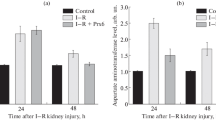Abstract—The aim of this study was to investigate the protective effect of exogenous peroxiredoxins with ischemia–reperfusion of an isolated kidney. The study was carried out using a model of isolated rat kidney perfusion ex vivo. A recombinant peroxiredoxin 6 was injected directly in the perfusion buffer. The high-molecular-weight dye Blue Dextran 2000 and urea were added to the perfusion buffer to determine the functionality of an isolated kidney. It was demonstrated that exogenous peroxiredoxin 6 in the cortical layer of an isolated kidney was localized in the vessels of renal glomeruli; in the medulla it was found in microvessels surrounding the thin tubules. The use of peroxiredoxin 6 decreases the degree of damage of nephron structures by two times compared with the damage in the control, which provides the preservation of ultrafiltration processes. A decrease in glomerular damage leads to a decrease in the content of Blue Dextran by two times compared with the damage in the control at the end of the perfusion period. A decrease in the damage of tubular structures indicates the active urea transport during perfusion. Thus, the inclusion of peroxiredoxin 6 in the perfusion buffer mediated a decrease in the damage of nephron structures and maintenance of the multifunctional state of renal glomeruli and tubules.





Similar content being viewed by others
REFERENCES
G. J. Chang, H. D. Mahanty, N. L. Ascher, et al., Am. J. Transplantol. 3 (10), 1259 (2003).
G. Kootstra, Transplantation 63 (7), 917 (1997).
A. I. Sanchez-Fructuoso, D. Prats, et al., J. Nephrol. 16 (3), 387 (2003).
S. F. Bagnenko, Yu. G. Moisyuk, A. E. Skvortsov, et al., Vestn. Transplantol. Iskusstv. Organov 11 (3), 17 (2009).
D. H. Koo and S. V. Fuggle, Transpl. Rev. 14 (2), 210 (2000).
B. M. Stubenitsky, M. H Booster, and A. P. Nidersting, Transpl. Int. 12, 83 (1999).
E. V. Karaduleva, E. K. Mubarakshina, M. G. Sharapov, et al., Bull. Exp. Biol. Med. 160 (5), 639 (2016).
V. I. Novoselov, N. K. Ravin, M. G. Sharapov, et al., Biophysics (Moscow) 56 (5), 836 (2011).
A. G. Volkova, M. G. Sharapov, V. K. Ravin, et al., Pul’monologiya 2, 84 (2014).
O. A. Palutina, M. G. Sharapov, A. A. Temnov, et al., Bull. Exp. Biol. Med. 160, 322 (2015).
M. G. Sharapov, A. E. Gordeeva, R. G. Goncharov, et al., Biophysics (Moscow) 62 (6), 998 (2017).
R. G. Goncharov, K. A. Rogov, A. A. Temnov, et al., Cell Tissue Res. 378 (2), 319 (2019).
M. G. Sharapov, V. I. Novoselov, and V. K. Ravin, Mol. Biol. (Moscow) 43 (3), 465 (2009).
J. Czogalla, F. Schweda, and J. Loffing, J. Vis. Exp. 117, e54712 (2016). https://doi.org/10.3791/54712
A. E. Gordeeva, A. A. Temnov, A. A. Charnagalov, et al., Dig. Dis. Sci. 60 (12) 3610 (2015).
T. V. Abrashova, Ya. A. Gushchin, and M. A. Kovaleva, Physiological, Biochemical, and Biometric Parameters of the Norn in Experimental Anials: A Handbook (LEMA, St. Petersburg, 2013) [in Russian].
A. M. Fedoruk, Novosti Khirurgii 26 (2), 215 (2018).
S. F. Bagnenko, K. Senchik, A. Skvortsov, et al., Vestn. Khirurgii 169 (2), 113 (2010).
R. Anaya-Prado and J. A. Delgado-Vazquez, Curr. Opin. Organ. Transplantol. 13 (2) 129 (2008).
M. R. Maximilian, M. Ph. Polyak, B. S. Ben OMar Arrington, et al., J. Surg. Res. 85 (1) 17 (1999).
F. A. Gage and Y. Vodovotz, Nitric Oxide 9 (3) 141 (2003).
M. Gregorini, V. Corradetti, E. Pattonieri, et al., J. Cell. Mol. Med. 21, 3381 (2017).
L. F. Tirapelli, D. F. Barione, B. F. Trazzi, et al.,Transplantol. Proc. 41, 4083 (2009)
S.V. Novoselov, I. V. Peshenko, V. I. Popov, et al., J. Cell Tissue Res. 298, 471 (1999).
J. R. Godoy, S. Oesteritz, E. M. Hanschmann, et al., Free Radic. Biol. Med. 51, 552 (2011).
D. R.Taft, Curr. Drug Discov. Technol. 1, 97 (2004).
I. A. Savin and A. S. Goryachev, Water-Electrolyte Disturbances in Neurointensive Care (Moscow, 2015) [in Russian].
Funding
This work was supported by the Program of Fundamental Studies of the Presidium of Russian Academy of Sciences Postgenomic Technologies and Promising Solutions in Biomedicine.
Author information
Authors and Affiliations
Corresponding author
Ethics declarations
Conflict of Interest
The authors declare that they have no conflict of interest.
Statement on the Welfare of Animals
The work with laboratory animals was carried out according to the guidelines of European Convention on the Protection of Vertebrate Animals Used for the Experiment and Other Scientific Purposes, 1986. Guidance on the Work with Laboratory Animals of the Institute of Cell Biophysics, Russian Academy of Sciences no. 57 from December 20, 2011, was the main document regulating the conduct of this study.
Additional information
Translated by A. Barkhash
Abbreviations: Prx6—peroxiredoxin 6.
Rights and permissions
About this article
Cite this article
Gordeeva, A.E., Sharapov, M.G., Evdokimov, V.A. et al. The Effect of Exogenous Peroxiredoxin 6 on the Functional Parameters of the Isolated Rat Kidney. BIOPHYSICS 65, 295–302 (2020). https://doi.org/10.1134/S0006350920020062
Received:
Revised:
Accepted:
Published:
Issue Date:
DOI: https://doi.org/10.1134/S0006350920020062




